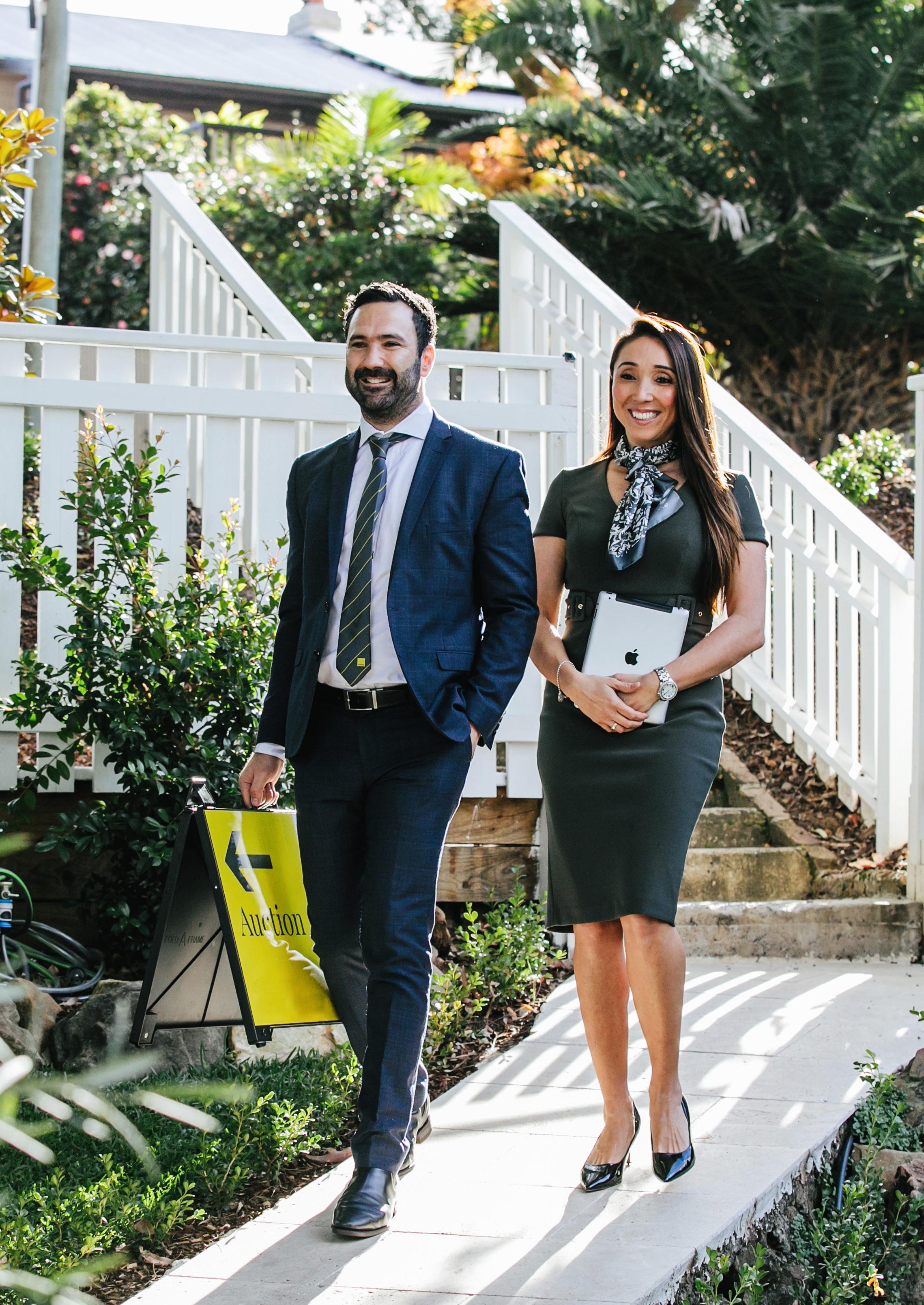

Landlord Information Guide


Welcome
Owning a rental property is a significant responsibility, and one that many Kiwis take on in pursuit of long-term financial security.
While the appeal of residential property investment remains strong, the rental landscape has changed dramatically. Compliance is more complex, regulations are stricter, and the risks of getting it wrong can be costly.
That’s
why expert support matters more than ever.
At Ray White, we’re proud to lead the industry in residential property management. With over 195 offices nationwide and more than $18 billion in assets under management, our team combines national strength with local expertise. We’re backed by industryleading systems, qualifications that exceed industry standards, and a commitment to service at every level.
Each and every year, Ray White is trusted to manage more than 3,000 new rentals nationwide - whether landlords are switching from another agency, moving on from selfmanagement, or expanding their investment portfolio. At the same time, over 13,000 tenants find their next home through our network annually.
For landlords seeking complete peace of mind, our flagship fullservice property management solution delivers exactly that. It’s designed to provide endto-end care, compliance, and results, and is trusted by tens of thousands of property owners across New Zealand.
We also understand that some landlords prefer to stay more involved. That’s why we created Ray White Choice - a flexible suite of services tailored to selfmanaging landlords. Whether you need help securing a great tenant, conducting inspections, or seeking expert advice, Ray White Choice offers professional support on your terms.
No matter how you choose to manage your investment, whether through our full property management service or by taking a more hands-on approach, Ray White is here to support you - and this guide is part of that support.
Inside, you’ll find clear and practical information to help you navigate each stage of the tenancy process. It covers everything from compliance and property preparation to inspections, rent collection, and recent legislative changes. Our goal is to help you stay informed, avoid common pitfalls, and make confident decisions as a landlord.

What type of landlord are you?
No two landlords are the same. Your goals, expectations, and level of involvement all play a role in shaping the kind of support you need. Understanding how you want to manage your investment is key to making smart decisions and staying compliant in today’s complex rental environment.
At Ray White, we know that successful property management starts with clear communication. We take the time to understand your unique investment goals and tailor our services accordingly - keeping you in control while expertly managing your property and obligations.
When you join us, you can expect open, ongoing conversations to help guide our partnership and understand your preferences. We’ll discuss topics including:
• What’s important to you in respect of how your property is managed?
• Your preferred method, level, and depth of communication
• Your investment goals and appetite for advice around portfolio growth
• Your approach to property maintenance and tenant relationships
• Your familiarity with insurance requirements and whether you have adequate cover in place
• Your understanding of current tenancy law and compliance standards, including methamphetamine risk, health and safety, and property maintenance
• Your understanding of common tenancy issues and how these are resolved, including fair wear and tear, accidental damage, and how these are resolved
• In our first conversation, we’ll walk you through what to expect at each stage of your landlord journey, from initial contact and compliance requirements to tenant sourcing, ongoing management, and regular portfolio reviews.

YOUR LANDLORD JOURNEY - WHAT TO EXPECT

Initial contact
Appraisal and meeting
Legislation compliance
Management agreement and induction
Feedback and survey

Getting ready to rent
First impressions matter, and getting your property rent-ready is one of the most important steps you can take to attract great tenants, minimise vacancies, and maximise your return. A well-presented, compliant home sets the tone for the tenancy and helps you avoid any costly issues down the track.
To ensure your property is ready for market, here are some essential factors to consider:
IS YOUR PROPERTY ‘REASONABLY CLEAN’?
The Residential Tenancies Act (RTA) requires landlords to provide a property that is ‘reasonably clean.’ However, what qualifies as ‘reasonable’ can be open to interpretation. We recommend starting strong with a professional clean before advertising. This not only attracts quality tenants but sets a clear standard of care from the outset.
DOES YOUR PROPERTY MEET MARKET EXPECTATIONS?
Consider how your property compares to others currently for rent in your area. Does it align with what today’s tenants expect at the price you are targeting? Small updates in presentation or functionality can often make a big difference to rental performance.
ARE ALL APPLIANCES, FITTINGS AND CHATTELS IN GOOD WORKING ORDER?
Everything provided with the property, from heat pumps and dishwashers to curtain rails and remotes, must be operational at the beginning of the tenancy. Addressing any of these maintenance issues early prevents disputes and ensures a smoother start for all parties.
ARE THE GROUNDS AND GARDENS TIDY AND USABLE?
Street appeal matters. Lawns, gardens, and outdoor spaces don’t need to be lavish, but they do need to be clean, safe, and well-maintained. Presentation plays a key role in shaping first impressions and sets the tone for tenant expectations around ongoing upkeep.
IS YOUR PROPERTY FULLY COMPLIANT?
Before any new tenancy begins, your property must meet all updated legal requirements. Noncompliance can lead to delays in signing a tenancy, financial penalties, or unnecessary tenancy disputes. Key compliance areas to consider can include:
• Healthy Homes Standards (HHS), covering heating, insulation, ventilation, moisture drainage, and draught stopping
• Building code and council consents
• Landlord insurance requirements
• Smoke alarms
• Methamphetamine risks.
Compliance documentation is now required to form part of every tenancy agreement. If you’re considering purchasing a new investment property, we recommend speaking with a Ray White property manager in advance to help avoid hidden costs and compliance-related delays.
EXPERT SUPPORT WHERE YOU NEED IT
Our team of trained property managers can assess your property’s readiness and provide expert advice on what’s required. Whether you’re looking for fullservice management or support with key steps, we offer flexible options that let you stay involved while relying on our expertise where it matters most.
For more details on legislation and compliance requirements, see the Property Management Legislation section on page 15.
REPAIRS AND MAINTENANCE
END OF TENANCY

INSPECTIONS
RENT COLLECTION
LEGISLATIVE COMPLIANCE
SETTING THE RENT
MARKETING YOUR PROPERTY
The property management process
TENANT SELECTION
TENANCY AGREEMENT AND BOND
The property management process
LEGISLATIVE COMPLIANCE
At the outset, your property must meet all tenancy legislation requirements, including Healthy Homes standards (heating, insulation, ventilation, etc.), working smoke alarms, and any relevant building or council regulations to ensure it is suitable for longterm rental. Find more details on these requirements on page 15.
SETTING THE RENT
We aim to achieve the best possible market rent for your property by assessing current demand, comparing similar listings in the area, and reviewing official rental statistics. We recommend reviewing the rent annually to ensure it remains competitive. If an increase is proposed and agreed upon, it must be provided with at least 60 days’ written notice, and can only occur once every 12 months - and not within 12 months of the tenancy start date.
MARKETING YOUR PROPERTY
Ray White uses proven marketing strategies to secure high-quality tenants and minimise vacancy periods. Properties are listed quickly across all major platforms including Trade Me, realestate.co.nz and Ray White’s websites, ensuring maximum exposure. Additional marketing can include weekly rental brochures, inter-office referrals and access to a national tenant database to match listings with qualified applicants fast.
TENANT SELECTION
We follow a thorough screening process that includes identity verification, comprehensive credit and background checks, and references from previous landlords. Each applicant is assessed not just on their history, but also on their suitability for your property based on our professional judgement. Importantly, we strictly adhere to the 2019 Privacy Commission guidelines, ensuring all information collected is relevant, necessary, and handled lawfully.
While we provide clear recommendations, the final decision always rests with you. Our goal is to help you secure reliable tenants who meet their obligations and treat your property with care.
TENANCY AGREEMENT, BOND AND INITIAL INSPECTION
Once a suitable tenant is selected and approved, we prepare a thorough Tenancy Agreement that outlines the key terms of the tenancy. This includes agreed rent, payment frequency, bond amount, responsibilities for maintenance, and any special conditions. The agreement is signed by all parties and becomes a legally binding contract that sets the foundation for the tenancy.
Before the tenant moves in, we collect the bond - typically the equivalent of four weeks’ rent - and lodge it with Tenancy Services, as required by law. We also conduct a comprehensive initial property inspection, documenting the condition of the home in detail, including written notes and photos. This inspection provides a vital reference point for any future discussions around wear and tear, damage, or end-of-tenancy expectations.
RENT COLLECTION AND ARREARS MANAGEMENT
Ray White operates under a zero-tolerance policy for rent arrears, using daily bank reconciliation. Should issues arise, we immediately follow up with the tenant by phone or text, then move through the required breach notices and Tenancy Tribunal application process (where necessary) to protect your income.
ROUTINE INSPECTIONS
Properties are recommended to be inspected at least quarterly, with comprehensive reports provided. Insurance policies often require a specific inspection frequency, so it is crucial to align this with your required terms.
REPAIRS AND MAINTENANCE
Timely repairs and maintenance are essential to preserving your property’s value, keeping tenants satisfied, and meeting legal obligations. We use qualified, trusted tradespeople to carry out repairs efficiently and cost-effectively.
Pre-approved spending limits are always respected, and we’ll consult you before proceeding with non-urgent work. However, urgent or emergency repairs may be actioned immediately if required to ensure tenant safety or to comply with our legal requirements. Our goal is to maintain your property to a high standard while keeping you informed and in control.
THE END OF THE TENANCY
The end of a tenancy begins as soon as notice is given, either by the tenant or the landlord. From that point, we manage the process to ensure everything runs smoothly, remains compliant, and causes minimal stress for everyone involved.
Once notice is received, we confirm the agreed end date in writing and begin preparing for the tenant’s departure. This includes setting expectations with the tenant, providing clear vacating instructions, and scheduling the final inspection. At the end of the tenancy, we carry out a thorough inspection and compare the property’s condition to the original entry report, using detailed notes and photographs.
All keys and remotes must be returned by the tenant, and the property should be left in a similar condition to how it was provided, allowing for fair wear and tear. We ensure compliance is met at every step and provide clear communication to prepare the property for its next phase - whether that’s a new tenancy or another purpose.

Common issues at this stage may include cleaning not meeting standards, items left behind, or minor damage. If problems arise, we work to resolve them promptly and fairly, using the bond where appropriate. If an agreement can’t be reached, we support landlords through the Tenancy Tribunal process as needed.
TENANCY TERMINATION NOTICES
Changes to tenancy termination laws came into effect on 30 January 2025, and apply to both new and existing tenancies:
Periodic tenancies
• 90 days’ notice: Landlords can terminate a periodic tenancy without providing a specific reason
• 42 days’ notice: Specific grounds apply, such as:
• The owner or their family will use the property as their primary residence (moving in within 90 days of tenancy expiry and staying for at least 90 days)
• The property is sold, and vacant possession is required
• A landlord’s employee or contractor is moving in (must be included in the tenancy agreement)
• Tenant notice: Tenants can end a periodic tenancy with 21 days’ notice.
Fixed-term tenancies
• End of term termination: Either party can end the tenancy by giving between 90-21 days’ notice before the tenancy expiry date. No reason required
• Automatic rollovers: If no notice is given, the tenancy becomes periodic. Once converted, periodic tenancy termination rules apply.
CARELESS DAMAGE AND TENANT LIABILITY
The Residential Tenancies Amendment Act 2019 (RTAA) outlines clear rules around tenant liability for careless damage. Tenants may be held responsible for any damage they or their guests cause, but liability is capped at four weeks’ rent or the landlord’s insurance excess, whichever is lower.
It’s important that landlords understand their insurance obligations, ensure their cover is adequate, and make tenants aware of the policy in place. Some insurers require proof that tenants were informed of key details, such as the excess, at the start of the tenancy.

MOVING BACK INTO YOUR PROPERTY
If a landlord or a family member intends to move into the property as their primary residence, the tenant must be given at least 42 days’ notice. This notice can be served at any time during a periodic tenancy. However, for fixed-term tenancies, tenants are entitled to remain in the property for the full duration of the agreed term, regardless of the landlord’s circumstances.
To meet the requirements under this specific notice, the landlord or family member must move in within 90 days of the tenancy termination date and reside in the property for at least 90 consecutive days.
SELLING A TENANTED PROPERTY
When selling a rental property with a sitting tenant, landlords must follow the correct legal process to protect the tenant’s rights and ensure a smooth sale.
While the initial steps remain the same no matter the tenancy type, once a sale is unconditional different steps must be followed depending on whether the tenancy is fixed-term or periodic.
STEP 1: NOTIFY THE TENANT OF THE UPCOMING SALE
Inform the tenant in writing that the property will be listed for sale. This is a good time to outline expectations for access and discuss whether a buyer is likely to require vacant possession.
STEP 2: CONFIRM VIEWING ACCESS ARRANGEMENTS
While tenants must allow reasonable access, it’s best to confirm agreed times for viewings or open homes in writing. This helps prevent misunderstandings and supports a smoother process if Tenancy Tribunal involvement becomes necessary later on.
STEP 3: LIST AND MARKET THE PROPERTY
Begin marketing the property, ensuring the tenant’s right to quiet enjoyment is respected and open communication is maintained throughout the campaign.
STEP 4: ONCE THE SALE GOES UNCONDITIONAL - WHAT NEXT?
Fixed term tenancy
• If the buyer requires vacant possession. Tenants are entitled to remain until the end of their fixed term unless they agree otherwise. Notice of termination can be issued no more than 90 days and no less than 21 days before the tenancy ends
• If the tenancy is to continue. Provide the tenant with the new owner’s contact details or confirm who will manage the property going forward.
Periodic tenancy
• If the buyer requires vacant possession. The landlord must give the tenant 42 days’ written notice (plus four days for service) after the sale becomes unconditional
• If the tenancy is to continue. Ensure the tenant receives updated contact details for the new owner or property manager.


Property management legislation
New Zealand’s rental landscape is evolving, with increasing regulation surrounding tenancy management and housing quality. These rules apply equally to professional property managers and private landlords, making it essential for all rental providers to stay informed.
Managing a tenancy today is heavily compliancedriven, with significant penalties for getting it wrong. While many landlords choose to self-manage, some do so without fully understanding their legal obligations or the risks involved.
Legislation is frequently updated, however, there are several well-established areas where landlords must already be meeting requirements, these include:
UNLAWFUL DWELLINGS
Not all rental spaces are created equal, and any property being lived in must meet minimum legal standards. Even if it wasn’t originally consented for residential use the rules apply, and include garages or sleepouts converted into living spaces.
TENANCY TERMINATION RULES
Understanding how and when a tenancy can be ended is vital. New laws affect notice periods, grounds for termination, and what’s required for both fixed-term and periodic tenancies.
HEALTHY HOMES STANDARDS (HHS)
All rental properties must meet minimum standards for heating, insulation, ventilation, moisture and drainage, and draught-stopping. Tenancy agreements must also include specific details confirming compliance.
RESIDENTIAL TENANCIES ACT AMENDMENTS (RTAA) LEGISLATION
Numerous changes have affected rules around rent increases, notice periods, minor alterations, assignment of tenancies, rental bidding, fibre broadband access and more.

INSURANCE DISCLOSURES
Landlords must disclose relevant insurance details in tenancy agreements, including policy coverage and claim limits.
SMOKE ALARMS
Working smoke alarms are mandatory in all rental properties, with both landlords and tenants carrying their own specific responsibilities.
METHAMPHETAMINE RISKS
Methamphetamine contamination remains a risk for landlords and tenants, with many factors at play including differing standards, and issues of liability and insurance.
HEALTH AND SAFETY DUTIES
Landlords must manage property hazards, ensure tradespeople are appropriately qualified, identify asbestos where relevant and comply with broader health and safety obligations.
All information presented in this guide is correct at the time of printing (July 2025). We recommend you speak to your Ray White property manager for any recent updates, as changes in our industry frequently occur.
Residential Tenancies Act Amendments
There have been several significant updates to the Residential Tenancies Act (RTA), including the various Residential Tenancies Amendment Acts passed in 2019, 2020, and 2024. The following pages summarise these changes and what they mean for landlords to help you stay informed and ensure you meet your legal obligations.
RESIDENTIAL TENANCIES AMENDMENT ACT 2019
The Residential Tenancies Amendment Act 2019 was the first in a series of major updates to the Residential Tenancies Act. It aimed to clarify key issues such as careless damage and liability, landlord insurance obligations, unlawful dwellings, and more. Key changes included:
CARELESS DAMAGE AND TENANT LIABILITY
• Tenants are responsible for the cost of careless damage, but their liability is capped at either four weeks’ rent or the landlord’s insurance excess, whichever is lower
• The legislation encourages responsible behaviour from tenants while aiming to ensure neither party is unfairly disadvantaged in cases of accidental damage.
LANDLORD INSURANCE
• Landlords must include insurance details in new tenancy agreements. This information should cover whether the property is insured and specify the excess amount
• Tenants must be provided with the relevant insurance details and may request a copy of the policy. If requested, it must be provided within a reasonable timeframe
• If a landlord fails to disclose or update this information in writing, they face a $500 penalty
• Insurers are prohibited from pursuing tenants for damage costs unless the damage was intentional or involved a criminal offence.
UNLAWFUL RESIDENTIAL PREMISES
• A property is considered a residential premises under the Residential Tenancies Act (RTA) if it is lived in or intended to be lived in, regardless of whether the appropriate building or resource consents exist
• Landlords must ensure that all rental premises, including minor dwellings or those significantly altered from their original use (such as a garage converted into a flat) meet the requirements of the RTA
• Tenants in unlawful premises are protected under the RTA and are entitled to rights regarding maintenance, safety, insulation, rent increases, bond lodgement, and termination notices
• The Tenancy Tribunal has complete jurisdiction and can order landlords to repay rent, and rule that tenants are not liable for arrears or damages unless they are unjust.
METHAMPHETAMINE CONTAMINATION
• Landlords may test for methamphetamine during a tenancy with 48 hours’ notice and must inform tenants of what is being tested and provide written test results within seven days
• Landlords must not rent contaminated premises with readings above a set level, or at levels which could prove to be harmful for inhabitants (see page 28 for further information).
RESIDENTIAL TENANCIES AMENDMENT ACT 2020
The Residential Tenancies Amendment Act 2020 brought significant reforms to tenancy law, expanding tenant rights and increasing landlord responsibilities. The changes impact key areas such as rent increases, minor alterations, recordkeeping, and enforcement powers. Key points include:
RENT INCREASES
• Limited to once every 12 months
• Increases cannot occur within 12 months of the tenancy start date or the last rent increase.
MINOR CHANGES
• Tenants can request to make minor alterations. (e.g., child locks, picture hooks, etc)
• Landlords must respond to any minor alteration requests within 21 days and cannot unreasonably decline the request
• Tenants are responsible for installation and removal costs. Landlords may impose reasonable conditions to any changes that occur (e.g. professional installation or reinstatement at the end of tenancy).
RENTAL BIDDING
• Bidding on rental properties is banned, and any advertising must display the rental price
• Landlords must not solicit bids or hold rental auctions
• Tenants may voluntarily offer more, but it cannot be encouraged.
ASSIGNMENT OF TENANCY
• Tenants can request to assign (transfer) their tenancy to another person.
• Landlords must respond in a reasonable timeframe and cannot unreasonably decline the request
• Standard vetting allowances remain in place to ensure tenant suitability.
FIBRE BROADBAND
• Tenants may request fibre broadband installation
• Landlords must approve if it is of no cost to them, unless legitimate exemptions apply (e.g. body corporate rules or weathertightness risk)
• Ongoing service costs are the tenant’s responsibility.
PRIVACY AND ACCESS TO JUSTICE
• Name suppression orders can be granted for substantially successful parties at the Tenancy Tribunal
• The Tribunal can also suppress names without request if it is deemed to be in the public or parties’ interests.
LANDLORD RECORDKEEPING
• All tenancy agreements must be in writing
• Landlords must retain property and tenancyrelated recordkeeping for 12 months post-tenancy
• Compliance documentation for the Healthy Homes Standards (HHS) must be provided on request.
STRONGER ENFORCEMENT POWERS
• The Ministry of Business Innovation and Employment (MBIE) can issue improvement notices or voluntary compliance agreements
• Non-compliance may result in financial penalties.
EXPANDED TENANCY TRIBUNAL POWERS
• The Tenancy Tribunal can now hear claims of up to $100,000
• Higher penalties apply to landlords who own six or more properties, recognising them as professional operators.
FAMILY VIOLENCE PROVISIONS
• Victims may withdraw from a tenancy with two days’ notice with the provision of evidence of what has occurred (e.g., protection order)
• If co-tenants remain, they pay a proportionately reduced rent for two weeks, before it returns to its previous rate.
• Landlords may not penalise tenants for ending a tenancy in these circumstances.
PHYSICAL ASSAULT
• A 14-day termination notice can be issued if a tenant assaults the landlord or their agent, and police lay charges.
RESIDENTIAL TENANCIES AMENDMENT ACT 2024
The Residential Tenancies Amendment Act 2024 introduced a range of changes affecting both landlords and tenants. These updates impact several key areas of tenancy law, with some applying to all tenancies and others applying only to new agreements. The following section outlines the main changes and what they mean for your responsibilities as a landlord.
BOND LODGEMENTS
• All bonds must now be lodged online via tenancy. govt.nz. Paper forms and email lodgements are no longer accepted. Signatures are not required for lodging or topping up a bond.
RETALIATORY NOTICES
• The Tenancy Tribunal can void tenancy termination notices issued in response to lawful tenant complaints or the exercising their rights (e.g. requests for maintenance, healthy homes compliance, or minor alterations).
• Tenants have 28 working days to apply to the Tribunal, and proven retaliation may result in landlord penalties of up to $6,500.
TERMINATION NOTICES
Changes to tenancy termination laws came into effect on 30 January 2025, and apply to both new and existing tenancies:
PERIODIC TENANCIES
• 90 days’ notice: Landlords can terminate a periodic tenancy without providing a specific reason.
• 42 days’ notice: Specific grounds apply, such as:
• The owner or their family will use the property as their primary residence (moving in within 90 days of tenancy expiry and staying for at least 90 days).
• The property is sold, and vacant possession is required.
• A landlord’s employee or contractor is moving in (must be included in the tenancy agreement).
• Tenant notice: Tenants can end a periodic tenancy with 21 days’ notice.
FIXED-TERM TENANCIES
• End of term termination: Either party can end the tenancy by giving between 90-21 days’ notice before the tenancy expiry date. No reason required.
• Automatic rollovers: If no notice is given, the tenancy becomes periodic. Once converted, periodic tenancy termination rules apply.
ELECTRONIC ADDRESSES
• Notices can be sent by email or other electronic address (e.g. messenger platform) if it is listed in the tenancy agreement. A physical address is still required. Electronic addresses remain valid for Tenancy Tribunal purposes for two years after their last use.
SMOKING
• Landlords can ban smoking inside the rental property with a clause in the Tenancy Agreement (excluding outbuildings). Outdoor smoking cannot be prohibited as tenants retain their rights to quiet enjoyment.
TRIBUNAL DECISIONS WITHOUT A HEARING
• Adjudicators can decide on Tribunal cases based on the provided documentation alone and without an in-person hearing, except for matters involving tenancy termination or landlord entry.
FAMILY VIOLENCE WITHDRAWALS
• Tenants can end fixed or periodic tenancies without penalty if they or their dependents experience family violence. This requires two days’ notice and evidence of what has occurred (e.g. protection order).
TRIBUNAL JURISDICTION
• When a landlord is taken to the Tribunal for multiple tenancies, each will be treated as a separate case with a $100,000 cap per tenancy, allowing for larger penalties across multi-property portfolios.
PET CONSENTS AND PET BONDS
New tenancy laws will soon give tenants greater rights to keep pets, with landlords only able to decline for valid reasons. These changes apply to new tenancies only and introduce clearer rules around approvals, conditions, and pet bonds.
• Pet consent framework
• Tenant request: This must be in writing, including pet type, size, and registration details
• Landlord response: Must reply within 21 days, approving (with conditions) or refusing (with valid grounds).
• Approval conditions may include:
• A pet bond of a maximum of two weeks’ rent
• Professional carpet cleaning upon exit
• Keeping pets restrained during inspections.
• Valid reasons for refusal include:
• Inappropriate pet type or size for the property
• Property unsuitable (e.g., no fencing)
• Prohibiting bylaws or body corporate rules
• The pet has a history of aggression or damage.
• Pet bond rules
• Maximum two weeks’ rent, in addition to the standard four-week bond
• Only one pet bond can be held at a time, regardless of pets owned
• The pet bond can be topped up if the weekly rent increases
• Refundable if the pet leaves or the tenancy ends without damage.
• Pet-related liabilities and fines
• Tenants are liable for pet-related damage beyond fair wear and tear
• It is unlawful for landlords to withhold consent unreasonably, and for tenants to keep a pet without written consent or breach the agreed conditions.
Note that disability assistance dogs are excluded from the pet consent and bond requirements, and all changes outlined in this guide may be subject to change upon the announcement of their commencement date.

Healthy homes standards
All private rental properties in New Zealand must meet healthy homes standards (HHS) by 1 July 2025. These minimum standards aim to ensure warmer, drier, and healthier homes for tenants while helping landlords protect their investment and reduce maintenance costs over time.
The standards cover five key areas, each of which contributes to a home that is more comfortable, healthier, and easier to maintain.
HEATING
The main living room must have one or more fixed heaters capable of reaching the required minimum heating capacity. Only certain types of heaters qualify; portable heaters, for example, are not compliant.
INSULATION
Existing insulation may need to be topped up or replaced with particular emphasis on minimum standards for ceiling and underfloor insulation, which may vary depending on the region.
VENTILATION
Living rooms, dining areas, kitchens and bedrooms must have openable windows or doors, with a total opening area equal to at least five percent of the room’s floor space. Kitchens and bathrooms must have extractor fans that ventilate to the outside.
MOISTURE INGRESS AND DRAINAGE
Properties must have effective drainage systems, including gutters, downpipes and drains. A sound moisture barrier is required under enclosed subfloors where practicable.
DRAUGHT STOPPING
Any unreasonable gaps or holes that cause noticeable draughts must be blocked. Open fireplaces must be sealed unless agreed otherwise with the tenant.
EXEMPTIONS
There are both specific and general exemptions that may apply to a rental property, including:
DEMOLITION OR MAJOR REBUILD (WITH CONSENT)
If the property is due to be demolished or significantly rebuilt and the required building consents have been obtained, a HHS exemption remains in place until the work begins or the tenancy ends.
FORMER OWNER AS TENANT (WITHIN 12 MONTHS)
If the current tenant was the previous owner of the property and the tenancy began immediately after the sale, the property is exempt for 12 months from the start of the tenancy. After that, all HHS requirements must be met.
ACCESS OR OWNERSHIP RESTRICTIONS
If the landlord cannot meet a standard due to legal restrictions - such as shared ownership, body corporate rules, or limited access to certain parts of the propertyan exemption may apply. Landlords must provide evidence and reassess this annually.

HEATING STANDARD
To meet the HHS obligations, landlords must install fixed heating in the main living room that can reach a minimum of 18°C on the coldest days. This ensures the property is warm, energy-efficient, and healthier for tenants.
Only certain types of heaters qualify - they must be fixed in place, capable of directly heating the space, and meet minimum kilowatt requirements based on the room’s size and features. Open-plan spaces are treated as one room and must be heated accordingly.
The easiest way to calculate the required heating capacity is to use the tenancy.govt.nz heating assessment tool, which takes into account your location, insulation levels, and room details.
COMMON HEATING COMPLIANCE QUESTIONS
What kind of heater do I need?
You must install a fixed heater (like a heat pump or panel heater) in the main living area that can reach the required heating capacity. Portable heaters are not compliant.
What if my heater isn’t big enough?
You can ‘top up’ with an additional small fixed electric heater (≤2.4kW), as long as the combined capacity meets the required total and the existing heater qualifies.
Can I keep my old heater?
Yes - if it was installed before 1 July 2019, has a capacity over 2.4kW, meets general safety and installation standards, and still provides at least 80 per cent of the required heating output.
Are there any exemptions?
Yes - If it’s not reasonably practicable to install a compliant heater (e.g., due to access issues, structural concerns, or risk of major damage), or if the property is a certified passive building, an exemption may apply.
INSULATION STANDARD
Ceiling and underfloor insulation has been required in rental properties since 2019, but the HHS introduced higher expectations around quality, coverage, and R-values. From 1 July 2025, all rental homes must meet these upgraded requirements, even if insulation was previously compliant.
Insulation must be in good condition, free from moisture, gaps, or compression, and meet the minimum R-values for your climate zone. In some cases, topping up or replacing older insulation is required.
COMMON INSULATION COMPLIANCE QUESTIONS
What condition should my insulation be in?
It must be dry, secure, and at least 120mm thick - without mould, gaps, or pests. If it’s compressed or degraded, it likely needs topping up.
What are the required R-values?
This varies by region, see the current R-value map shown here to check
Do I need to reinsulate if I met the 2016 rules?
Some landlords may need to upgrade existing insulation if it has settled or no longer meets the required R-values. In these cases, an update is necessary to remain compliant.
Are there any exemptions?
Yes - if access is unsafe or impractical (e.g., slab foundations or tight ceiling spaces), or if another dwelling sits directly above or below. Partial exemptions may apply to underfloor insulation installed legally before 2008 with a Code Compliance Certificate (CCC).


VENTILATION STANDARD
Good ventilation is key to preventing mould, damp, and condensation. The Healthy Homes Standards require proper airflow through windows and mechanical ventilation in moisture-prone areas.
All living spaces must have openable windows or doors to the outside. Kitchens and bathrooms must have externally vented extractor fans to remove moisture effectively, especially when cooking or showering.
COMMON VENTILATION COMPLIANCE QUESTIONS
What is the window requirement?
Each habitable room must have at least one openable window or door to the outdoors. The total openable area must equal five per cent of the floor space.
Do extractor fans need to be a certain size?
Yes - fans installed after 1 July 2019 must meet minimum airflow standards:
Kitchens: 50L/sec or 150mm diameter
Bathrooms: 25L/sec or 120mm diameter
Are older fans compliant?
If they were installed before 1 July 2019, they must vent to the outside and be in good working condition (e.g., ducting connected and not blocked).
Are there any exemptions?
Yes - if it’s not reasonably practicable to install a compliant fan or if the room was legally built without one and still meets the original building standard.
MOISTURE INGRESS AND DRAINAGE STANDARD
All rental properties must be kept dry from the ground up, with the Healthy Homes Standards requiring effective drainage and, where necessary, a ground moisture barrier to prevent rising damp.
Drainage includes working gutters, downpipes, and outfall systems. If the property has an enclosed subfloor (where more than 50 per cent is blocked off), a moisture barrier is mandatory unless installation isn’t reasonably practical.
COMMON MOISTURE INGRESS AND DRAINAGE COMPLIANCE QUESTIONS
What does good drainage include?
The property must remove stormwater efficiently with functioning gutters, downpipes, and drains. Gutters must not overflow or be blocked.
What’s a ground moisture barrier?
It’s a heavy-duty polythene sheet or specialist barrier laid on the ground under an enclosed subfloor to stop rising damp.
What makes a subfloor ‘enclosed’?
If 50 per cent or more of the perimeter is blocked by walls, cladding, garages, or natural obstructions like earth.
Are there any exemptions?
Yes - if installing the barrier would require major building work, pose health/safety risks, or isn’t reasonably practical for a professional to complete.


DRAUGHT STOPPING STANDARD
The Healthy Homes Standards require landlords to block noticeable draughts from gaps, holes, or unsealed fireplaces, as uncontrolled airflow can prevent a home from staying warm.
Even small gaps can make heating ineffective, so repairs may be needed to doors, windows, floorboards, or chimneys to bring a property up to standard.
COMMON DRAUGHT STOPPING COMPLIANCE QUESTIONS
What is considered a draught that needs fixing?
Any gap or hole that lets in noticeable cold air. As a guide, gaps wider than 3mm (about the width of a $2 coin) should be sealed.
Do I have to block the fireplace?
Yes, open fireplaces must be blocked unless the landlord and tenant both agree in writing to keep them open and usable.
What are common problem areas?
• Gaps under external doors
• Loose window frames or broken latches
• Cracked floorboards or skirting gaps
• Unsealed pet doors
Does the property’s age matter?
No, even character homes must comply. The age of the property is not a valid reason for ignoring draught issues, or complying with the standard.
Smoke alarm requirements
Working smoke alarms are compulsory in all rental properties. New smoke alarms must be photoelectric, and landlords are responsible for ensuring they are fully operational at the start of each new tenancy. Failure to meet these requirements may result in financial penalties of up to $7,200.
PLACEMENT REQUIREMENTS
• Within 3 metres of each bedroom door, or in every room where a person sleeps
• On each level of a multi-storey home
• In all rental homes, including boarding houses, caravans, and self-contained sleep-outs.
SMOKE ALARM STANDARDS
• Any new smoke alarm installed after 2016 must be photoelectric with at least an eight-year battery life, or be hard wired
• They must be installed according to the manufacturers instructions
• Compliant with standards: AS3786:1993 (AU); or equivalent international standard: UL217 (USA), ULCS531 (Canada), BS5446: Part 1 (United Kingdom), BS EN 14604 (United Kingdom) or ISO12239 (International).
NEW BUILD REQUIREMENTS
• For any new build properties, or rentals undergoing major renovations, updated rules for smoke alarms apply. This requirement applies to houses built (or renovated) after the most recent updates to the Building Code
• There must be interconnected smoke alarms in every bedroom and living space, on every level of a new build home. This means when one alarm goes off, they all go off, giving occupants the best possible chance to react in an emergency
• Where a kitchen is separated from living spaces and hallways by closable doors, an alarm suitable for kitchens (which may be a heat alarm) must be installed in the kitchen.
INSTALLATION GUIDELINES
• Landlords must install alarms (not tenants) according to manufacturer instructions and NZS 4514:2009 placement standards
• The installation of any alarm must avoid dead air spaces and follow recommended distances from ceilings, beams and walls.
Ray White recommends that landlords consider the use of an annual smoke alarm service provider as a best practice step to ensure your obligations are always being met.
These types of providers will consistently check that your smoke alarms are in working order and replace them as part of their service, when required. To find out more, speak with your Ray White property manager.
MAINTENANCE RESPONSIBILITIES
Landlords are responsible for ensuring the smoke alarms are working at the beginning of every new tenancy, and remain so throughout the tenancy. Tenants must replace batteries during a tenancy (if removable) and report issues as soon as possible.
INSTALLATION GUIDELINES
Landlords must install alarms (not tenants) according to manufacturer instructions and New Zealand Standard 4514 guidelines (see illustrations).
The installation of any alarm must avoid dead air spaces and follow recommended distances from ceilings, beams and walls.
Ray White recommends that landlords consider the use of an annual smoke alarm service provider as a best practice step to ensure your obligations are always being met.
These types of providers will consistently check that your smoke alarms are in working order and replace them as part of their service, when required. To find out more, speak with your Ray White property manager.

Methamphetamine
Methamphetamine use and manufacture in rental properties pose serious health and financial risks, and its crucial landlords understand the many factors at play in relation to this issue. Contamination can impact tenant wellbeing, trigger costly remediation, void insurance cover, and result in Tenancy Tribunal claims.
While some landlords may believe methamphetamine contamination is becoming less common, it remains a real issue in many communities. In response, insurers have tightened their policy conditions, with many now requiring pre-tenancy baseline testing for cover to apply, along with reduced claim limits or higher excesses.
No matter the circumstances, pre-tenancy baseline testing and ongoing testing between each tenancy is the single best way to reduce risk and ensure liability can be directed to any responsible party.
Tip: Check your insurance policy for methamphetamine-related requirements. If baseline testing is a condition of cover, make it part of your standard process.
WHAT’S THE STANDARD?
New Zealand has two influential, but not legally binding, standards for methamphetamine contamination and their use may depend on the specific circumstances:
NZS 8510:2017 sets a conservative cleanup threshold of 1.5µg/100cm² in high-use areas, and 3.8 µg/100cm² in any limited use area of the property.
The 2018 Gluckman Report commissioned by the Prime Minister’s Chief Science Advisor, suggests that exposure below 15µg/100cm² is unlikely to pose a health risk, especially when contamination stems from use rather than manufacture.
These two thresholds continue to shape how Tenancy Tribunal cases are assessed:
• The Tribunal typically uses the Gluckman threshold (15µg/100cm²) as the benchmark for whether contamination is harmful and warrants remediation
• However, some insurers still use the NZS 8510 standard, requiring cleanup above 1.5µg/100cm².
There is currently no legal requirement to test, and no law sets a definitive maximum inhabitable level. However, the government has signalled its intent to introduce formal testing regulation in future.
IS TESTING STILL REQUIRED?
Testing isn’t mandatory but is highly recommended as a risk management tool. When considering this, we suggest landlords consider the following questions:
• What does my insurance policy require?
• How can any liable party be held accountable without evidence they have caused the contamination?
• What is my risk tolerance and ability to cover remediation costs if contamination is found?
WHAT IS BEST PRACTICE FOR LANDLORDS?
While not required by law, the following actions are widely considered best practice to reduce risk and strengthen your position if issues arise:
• Conduct a baseline test between tenancies, even if there are no signs of drug use at present
• Understand the risk in finding contamination with no prior testing or results, especially where an existing tenancy is in place
• Include a clause in your tenancy agreement stating that testing for methamphetamine may be conducted with proper notice, outlining the tenant’s liability if contamination is found
• Remember that the Tenancy Tribunal has confirmed baseline testing can provide critical evidence in resolving disputes and assigning liability for contamination.
HOW TO MINIMISE RISK AND PROTECT YOUR INVESTMENT?
These practical steps can help reduce exposure and support a stronger insurance or Tribunal outcome if contamination occurs:
• Test between tenancies to establish a clear baseline
• Keep detailed records of all test results, including dates and areas tested
• Use qualified professionals for testing and remediation. Do-it-yourself kits are not recommended CONTAMINATION LEVEL
<1.5µg/100cm².
1.5-15µg/100cm².
Below NZS 8510 threshold.
Above NZS 8510 but below Gluckman threshold.
• Take prompt action if contamination is confirmed above relevant thresholds.
• Work closely with your property manager and insurer to follow the correct process.
HOW TO INTERPRET CONTAMINATION LEVELS?
Different levels of meth contamination require different responses. The table below helps explain what each level means and what actions landlords may need to take in order to stay compliant and protect their property.
>15µg/100cm².
Above Gluckman threshold.
No remediation required. Property is considered clean.
Low health risk.
Cleaning may be appropriate, but full remediation is not usually required unless evidence of heavy use or manufacture.
Considered unsafe. Full remediation is required before the property can be rented again.
Suspected methamphetamine lab.
Regardless of levels. Treated as high risk. Notify authorities and undertake full remediation.
HOW CAN WE HELP?
Ray White property managers are supported by robust methamphetamine risk management policies that help staff recognise and respond to potential contamination issues. All offices have access to approved tenancy agreement clauses and acknowledgements, ensuring incoming tenants are made aware that testing may occur.
If methamphetamine contamination is suspected, our property managers can draw on the support of tenancy law specialists to guide you through the correct steps and legal obligations. We encourage landlords to take a best-practice, low-risk approach, and we’re here to provide practical support should an issue ever arise.
For tailored advice, speak with your Ray White property manager or visit tenancy.govt.nz for more information.
Swimming pools
The Building (Pools) Amendment Act 2016 came into place in order to improve the level of compliance relating to pool barrier requirements.
The Act applies to all residential pools and small heated pools with a maximum depth of 400mm or more. Key changes for landlords mean:
• Residential swimming pool barriers must be inspected every three years
• Safety covers will be able to be used as barriers for spa pools and hot tubs
• Territorial authorities will have better tools to enforce pool barrier requirements, including issues notices to fix, and infringement notice
• Landlords are required under the Act to ensure that the fence and gates around any swimming pool comply with the Act at all times.
We recommend you contact your local council if you have any questions or need information on how you can arrange your own swimming pool assessment.


Health and safety
Under the Health and Safety at Work Act (HSWA) 2015, landlords and property managers are classified as Persons Conducting a Business or Undertaking (PCBUs). This means that both parties share equal responsibility for the health and safety of anyone involved with, or affected by work carried out at a rental property, including repairs, maintenance and viewings.
LANDLORD RESPONSIBILITIES
Where multiple PCBUS are involved (e.g., landlord, property manager, contractor), each must take all reasonably practicable steps to manage risks. For instance, a landlord cannot delegate full responsibility to a contractor should any issues arise.
Key healthy and safety obligations include:
• Identifying and managing all risks related to the required work at the property
• Ensuring contractors are competent and have their own health and safety plans
• Confirming contractors understand the site-specific risks
• Checking certifications and insurance of contractors before work begins.
HOW CAN WE HELP?
Ray White property managers have access to robust health and safety procedures and understand the importance of proper hazard identification, risk reporting, and having our contractors complete detailed healtwh and safety checks.
By working with Ray White, you can be confident your obligations under the Act are being met, minimising liability and supporting safer outcomes for everyone involved.

Asbestos
Under the Health and Safety at Work (Asbestos) Regulations 2016, a rental property becomes a ‘workplace’ when work is planned or undertaken that could disturb asbestos-containing materials. In these situations, the landlord (as a PCBU) has legal duties to manage associated health risks.
LANDLORD RESPONSIBILITIES
If there’s any risk of exposure to respirable asbestos fibres, landlords must:
• Identify asbestos (Regulation 10)
• Analyse samples (Regulation 11)
• Clearly indicate presence and location (Regulation 12)
• Create and maintain an asbestos management plan (Regulations 13-14).
This applies to any work (e.g., renovations, repairs, demolition) where asbestos exposure is a risk. Contractors and property managers are also considered PCBUs, and landlords cannot rely on them alone to meet obligations.
WHEN DOES THE LAW APPLY?
Worksafe New Zealand clarifies that asbestos regulations apply when a rental property becomes a workplace (e.g., when work begins or is being planned). However, waiting until work begins before addressing asbestos-related concerns may increase exposure risk and the likelihood of non-compliance.
PROACTIVE VERSUS REACTIVE LANDLORD APPROACH
Ray White recommends a proactive approach to asbestos assessment and management before urgent work arises. See the following tables to better understand the nuances of a proactive vs reactive approach.
Proactive approach
PROS CONS
Full compliance reduces
Avoids delays or emergency accommodation costs
Costs are controlled and planned
Upfront assessment costs
Potential for immediate removal recommendations (and associated costs)
Reactive approach
PROS CONS
No upfront cost if work is planned May delay urgent repairs
Higher costs in crisis situations
Greater risk of non-compliance and liability
Ultimately, the decision rests with the landlord, but acting early provides peace of mind and avoids costly surprises.
HOW CAN WE HELP?
Ray White property managers are supported in asbestos best practice management and work closely with qualified assessors. We can:
• Help to coordinate assessments and management plans
• Provide guidance tailored to your property
• Ensure you meet all your PCBU obligations
For more, speak to your Ray White property manager or visit worksafe.govt.nz for official guidance.
Landlord Obligations: the law and the Act
The Residential Tenancies Act (RTA) 1986 sets out a framework that all landlords and tenants must adhere to when entering into any tenancy agreement. These rules have been developed to provide clear guidelines and boundaries for all those involved in the process.
LANDLORD RESPONSIBILITIES
Before and during the tenancy, landlords must:
• Provide the property in a reasonably clean and tidy condition
• Maintain the property in a reasonable state of repair throughout the tenancy
• Comply with all relevant building, health, and safety requirements
• Ensure the uninterrupted supply of gas, electricity, water, telephone, or other essential services, except where interruption is necessary for maintenance or to prevent danger
• Ensure all locks are functional and the property is reasonably secure
• Install smoke alarms that are compliant and in good working order, with batteries installed at the start of each new tenancy (where applicable).
Additional landlord obligations during the tenancy include:
• Not requiring more than four weeks’ rent as bond, or more than two weeks’ rent to be paid in advance
• Ensuring that tenants in neighbouring properties they own do not disturb one another
• Reimbursing tenants for the cost of emergency repairs, provided the tenant first attempted to contact the landlord and was not responsible for the issue
• Providing at least 24 hours’ written notice (between 8am and 7pm) before entering the property for maintenance or repairs
• Gaining the tenant’s consent and visiting at a reasonable time when showing the property for sale or viewings
• Not using force, or the threat of force, to enter or attempt to enter the property while it is occupied
• Giving at least 48 hours’ notice before conducting a routine inspection.
TENANT RESPONSIBILITIES
Before and during the tenancy, tenants must:
• Pay rent on time
• Ensure the property is occupied principally for living purposes
• Pay utility charges (e.g., power, gas, etc)
• Keep the property reasonably clean and tidy
• Report damage or maintenance needs as soon as possible
• Fix or pay for any intentional or careless damage caused by them or their visitors
• Replace expired smoke alarm batteries (where applicable) and report faults. Alarms must not be tampered with
• Pay for water usage only if separately metered and charged.
Additional tenant obligations during the tenancy include:
• Prevent any intentional damage or illegal activity
• Not use the premises, or permit the premises to be used, for any illegal purpose
• Do not disturb the neighbours
• Ensure they do not exceed the maximum number of occupants stated in the agreement
• Not change locks or make alterations without the landlord’s permission
• Remove all personal items and rubbish when vacating
• Leave the property in a clean, tidy condition at the expiry of their tenancy and return all keys
• Leave any landlord-provided items (e.g., furniture or appliances) behind.
FINES AND PENALTIES
Under the RTA, landlords and property managers acting on their behalf must comply with the law or risk being ordered to pay exemplary damages (fines) for unlawful acts. Below are some examples of tenancy law breaches and their associated fines:
Why choose Ray White property management?
“Ray White proudly manages more than 23,000 rental properties nationally and leads the market with a commitment to performance, innovation, and service.
We empower our property managers with the best systems and technology to protect our clients’ investments and enhance returns. In an ever-changing environment, our dedication to excellence and market leadership ensures both property owners and tenants are in the best hands.”
DANIEL COULSON Chief Executive, Ray White New Zealand
At Ray White, property management is more than just ticking boxes - it’s about protecting your investment, maximising its return, and helping you achieve your long-term financial goals.
With more than $18 billion in rental assets under management across 195 offices nationwide, we’re proud to set the standard in an evolving industry.
Property management is complex and demanding, requiring skill, experience, and up-to-date knowledge. It’s why New Zealand landlords, on average, entrust us to care for more than 4,000 new investment properties each and every year, and more than 13,000 tenants find their next home through our network.

SO WHAT EXACTLY MAKES RAY WHITE DIFFERENT?
Raising the bar: a new standard in property management
At Ray White, we don’t just adapt to industry changes, we lead them. Which is why we introduced ‘A New Standard in Property Management’ - a bold step forward in property management excellence.
This industry-leading initiative sets a new benchmark for how we operate and deliver the property management service to our customers, focusing on three core pillars of educational standards, financial security, and customer choice.
The New Standard in Property Management is unmatched amongst our competitors and its three pillars provide landlords and tenants with the service they deserve - in an industry where no rules, standards, or requirements currently exist.
A more educated, responsible, and flexible environment for New Zealand landlords and tenants is entirely achievable. It’s what our customers deserve, and it’s exactly what we’ve delivered.

EDUCATION STANDARDS
• One of the most qualified property management networks in New Zealand with the highest available qualifications represented in nearly every office (NZQA Level 4)
• Property managers who better understand the legal framework and property management process for all customers
• Ongoing training requirements ensure staff and customers remain up to date with evolving legislation.
FINANCIAL SECURITY
• Dedicated client fund accounts (Trust Accounts) to help protect our customers’ income
• Independent financial reviews, providing customer security through ongoing checks and monitoring of client funds
• Public indemnity insurance to safeguard both people and property when the things no one can predict occur.
CUSTOMER CHOICE
• Full wraparound support and flexible options for landlords - taking control of your tenancy but with an end to the one-sizefits-all approach to fees
• Exclusive products designed for selfmanaging landlords and their desired level of tenancy control - pick and choose what you like.

Setting the standard through education
SETTING THE STANDARD THROUGH EDUCATION
Professional development is one of the key ways Ray White sets the standard in property management. From legislative updates and Healthy Homes Standards (HHS) compliance to conflict resolution, arrears management, and leasing strategies, our property management teams are equipped with the knowledge and skills to deliver industry-leading service.
We believe great service starts with great training— which is why our people have ongoing access to highquality professional development. This ensures you're working with experts who are continually learning, improving, and staying ahead of the curve.
Staff are provided with ongoing access to professional development across key areas such as:
• HHS compliance
• Tenancy law updates
• Monthly live tenancy support sessions
• Methamphetamine awareness
• Dispute resolution and arrears management
• Property care and maintenance
• Dedicated legal support via Tenancy Practice Services.
As part of our ‘New Standard in Property Management’ initiative, Ray White has become one of New Zealand’s most qualified property management networks.
Over 90 per cent of our offices (and counting) now have team members with New Zealand Qualifications Authority (NZQA) Level 4 certification - the highest currently available. It’s a benchmark few can match.
LEGISLATIVE AND COMPLIANCE SUPPORT
In today’s rental market, compliance is not optional. Landlords must meet a wide range of legal obligations under the Residential Tenancies Act, Healthy Homes Standards, insurance disclosure requirements,
methamphetamine risk management, and more. Even a single missed requirement can result in financial penalties, disputes, or issues with insurance.
Ray White provides expert guidance to help landlords stay compliant and avoid these risks. Every property manager in our network receives ongoing training and has direct access to tenancy law specialists through Tenancy Practice Services. This ensures your property is being managed in line with current legislation and industry best practice.
Our support covers everything from preparing Healthy Homes documentation and managing rent increases to responding to tenancy law changes and representing landlords at Tribunal. We help you stay ahead of new requirements and avoid the common compliance traps that often catch out self-managing landlords.
With Ray White, you are not just hiring someone to collect rent. You are working with a team that actively protects your investment and ensures your legal obligations are met with confidence
PROPERTY MAINTENANCE - PROTECTING YOUR INVESTMENT
Effective property maintenance is essential to preserving the value of your rental, meeting legal obligations, and ensuring a positive experience for your tenants. Property maintenance is a legal responsibility and one that requires careful planning, prompt attention, and clear communication. At Ray White, we approach maintenance with the goal of:
• Maintaining the long-term capital value of your property
• Preventing minor issues from becoming costly repairs
• Proactive advice and planning - not just urgent reaction to issues
• Ensuring all legal obligations are met and communication is clear throughout the process.
Communication is key. Our property managers will keep you fully informed of urgent issues as they arise and offer proactive advice on preventative maintenance to help safeguard your investment over time.
We work with a trusted network of qualified tradespeople to provide competitive pricing and high-quality work. If you have a preferred contractor, your property manager can arrange for them to be used where appropriate.
To further enhance the maintenance experience, the majority of Ray White offices utilise the Tapi platform, a leading tenancy maintenance system. Tapi allows tenants to report issues 24/7 via a simple online system, while landlords benefit from faster job turnaround, full transparency, and automated updates.
Every office in our network follows robust, wellestablished maintenance procedures to ensure consistent, high-quality results. Whether through trusted local relationships or tailored systems, your property is in capable hands.
RETURN ON INVESTMENT
Placing your property in the hands of a Ray White property manager means partnering with a professional whose goal is to protect your asset and help you grow your return over time. Across our national network, our property managers are skilled in implementing strategies that drive long-term value for landlords, including:
• Conducting regular rent reviews and implementing increases where appropriate
• Leveraging strong marketing campaigns to minimise vacancy and attract high-quality tenants
• Carrying out routine inspections to protect your asset and reduce risk
• Implementing ongoing maintenance schedules to reduce long-term costs
• Enforcing zero-tolerance rent arrears policies
• Reducing vacancy periods to boost your annual yield
• Carefully screening tenants to minimise property wear and tear
• Encouraging fixed-term tenancies to help secure a stable income stream.
For many self-managing landlords, implementing these strategies can be challenging. Whether due to limited time, knowledge, or confidence when dealing with tenants, key opportunities are often missedand avoidable risks introduced.
Ray White property managers understand how to strike the right balance: strong tenant relationships built on clear communication, while never losing sight of your long-term financial goals.
Managing a tenancy well is no different to running a successful business. When you engage Ray White, you can be confident your investment is operating at its optimum, being professionally managed with a strategic view of growth, performance, and protection.
CUSTOMER CHOICE, REDEFINED
Ray White is different. While most agencies offer a one-size-fits-all service model, we know that not all landlords are the same. That’s why we created Ray White Choice - our industry-exclusive range of services designed specifically for self-managing landlords.
With Ray White Choice, you retain full control of your tenancy while accessing targeted professional support where it matters most. It’s a flexible, tailored approach that delivers better outcomes for both landlords and tenants.
Choose the services you need, when you need them:
• Routine inspections: Keep your property compliant and in great condition
• Initial tenancy inspections: Comprehensive reports with detailed photos and maintenance advice
• Rent management and arrears support: Tools and templates to manage payments with confidence
• Casual letting: End-to-end tenant sourcing, advertising, screening, and lease documentation
• Landlord consulting: Strategic guidance on rent reviews, documentation, compliance and more.
Whether you prefer to stay hands-on or simply want occasional support, Ray White Choice gives you the flexibility to self-manage with confidence - backed by New Zealand’s leading property management network.


COLLECTIVE STRENGTH
Ray White goes far beyond simply managing properties. Our goal is to become the leading property and financial services provider in the AsiaPacific region.
Over the years, we’ve built a truly global, familyowned business that now offers more value-added services than any other real estate brand in New Zealand. A key part of the strength we bring lies in the collective power of our broader group - available for every landlord to tap into.
RAY WHITE SALES
If you’re considering selling your investment property or family home, or looking to grow your portfolio, Ray White offers comprehensive real estate services to support you at every stage. With over 2,100 licensed real estate agents across more than 195 offices nationwide, we provide expert advice and solutions tailored to your goals.
Our agents are experienced across a range of sales strategies, including auctions, private sales, and offmarket transactions, allowing us to recommend the most effective approach for your situation. We offer detailed market appraisals, strategic marketing plans, and access to a wide buyer network to help maximise your property’s exposure and sale price.
For investors, we provide insights into market conditions, zoning changes, and potential development opportunities, helping you make wellinformed decisions. Our close collaboration with Loan Market also allows for seamless coordination between selling and financing needs.
Whether you’re a first-time seller or a seasoned investor, Ray White’s experience, scale, and local knowledge make us a trusted partner in achieving your real estate ambitions.
LOAN MARKET
As part of the White family business group, Loan Market is New Zealand’s largest network of mortgage advisers, with over 150 advisers settling more than $6 billion in home loans each year. Since 1994, they’ve helped Kiwis find the right loan through a panel of over 25 trusted banks and lenders.
Loan Market advisers offer free, expert support to property investors, helping choose the right loan structure and features to suit financial goals. Whether you’re buying your first rental or expanding a portfolio, they can guide you through options like redraw, offset accounts, and extra repayments to manage lending more effectively.
Investment loans can be simple or more complex, depending on things like personal debt and cash flow. In many cases, it makes sense to reduce personal debt first before taking on more investment lending. Whatever stage you’re at, Loan Market can help simplify the finance process.
INSURANCE
By choosing Ray White as your property manager, you can gain access to exclusive landlord insurance policies that offer broader and more comprehensive cover than those available to self-managing landlords.
These policies are designed to protect against tenancy-specific risks such as loss of rent, damage to the property or contents, and even pet-related damage. With increased awareness around issues like methamphetamine contamination and tenant liability for careless damage, having the right insurance in place is more important than ever.
Talk to your property manager to learn more about the policies available to you once your property is under our management.


About Ray White
In our industry there is nothing more powerful than experience.
Ray White is a proud and strong family business with more than 120 years experience in the property industry to date and now, four generations later, we remain family owned. This goes a long way in ensuring those strong family values are preserved and madwe a clear part of everything we do.
Founded in 1902, we are now one of the largest real estate companies in the Asia-Pacific region made up of 12,000 members, ranging from business owners, salespeople, property managers, business development managers, administrators, marketers and everyone in between across 10 countries - meaning your home will be managed by the most experienced professionals in the industry.
DID YOU KNOW
23,000+ $700 Million+
Ray White manages more than 23,000 investment properties in New Zealand with an asset value of more than $18 billion.
Ray White New Zealand facilitates the transfer of more than $700 million in rent to landlords each and every year.
Ray White receives more than 250,000 enquiries each year from tenants who are looking to view our available rental properties.
New Zealand landlords entrust Ray White with over 4,000 new properties to manage on their behalf every year.
250,000 4,000 6,500
Ray White receives more than 6,500 completed tenancy applications for our rental properties every single month.
With staff spread from Kaitaia to Invercargill - and everywhere in between, Ray White is one of the largest property management companies in New Zealand, putting you in touch with more tenants and offering more support than our competitors.

Frequently asked questions
WHEN CAN I VISIT MY TENANTED PROPERTY?
A landlord can request to visit a property whenever they like, however, this can occur no more than once every four weeks and must come with at least 48 hours’ written notice to the tenant.
WHAT IF A REPAIR IS NEEDED AFTER HOURS?
Our policy on what qualifies as an emergency repair is clearly explained to all tenants at the beginning of their tenancy and is guided by the Residential Tenancies Act (RTA).
Tenants are provided with mobile and after-hours contact details should an emergency arise. In these situations, your property manager will exercise sound judgement and caution to ensure we meet our legal obligations to the tenant while also respecting your preferences as the property owner.
WHAT DO YOU EXPLAIN TO TENANTS BEFORE THEY MOVE IN?
As part of our tenant induction process, we take the time to clearly outline key expectations and responsibilities. This includes education on:
• Rent payment dates and the required payment methods to ensure rent is always paid on time
• What constitutes an emergency repair, and who to contact
• How often routine inspections will take place and what we look for
• General tenant responsibilities and the relevant legal obligations under the RTA.
To support this, all Ray White New Zealand property managers are equipped with a comprehensive Tenant Information Guide, designed to educate tenants and reduce the likelihood of issues throughout the tenancy. If you would like a copy of this guide, please contact your property manager directly.
WHO PAYS FOR WATER CHARGES?
Tenants are responsible for all metered water usage charges, while landlords cover the daily line or supply charges. If the property is serviced by a water tank, the landlord must ensure the tank is full at the start of the tenancy.
IS INSURANCE COMPULSORY?
Landlord insurance is not compulsory in New Zealand, but it is strongly recommended, and any insurance cover in place must be acknowledged within the tenancy agreement.
Standard house insurance may not cover tenancyrelated risks such as accidental damage, rent arrears, methamphetamine contamination, or legal costs associated with disputes. Specialised landlord insurance policies help protect your investment and reduce your financial risk. We encourage all property owners to review their insurance cover carefully and ensure it meets the specific needs of a rental property.
CAN I REQUEST TENANTS HIRE A PROFESSIONAL CLEANER WHEN THEY VACATE?
Tenants are not legally required to use professional cleaners when moving out. They must leave the property in a ‘reasonably clean and tidy’ condition, and if this standard isn’t met the cost of additional cleaning can be deducted from the bond.
The interpretation of ‘reasonably clean’ can be subjective, with Tenancy Tribunal challenges common if professional cleaning charges are forced onto a tenant.
ARE TENANTS ALLOWED TO INSTALL PICTURE HOOKS?
Tenants must seek permission before installing picture hooks, nails, screws, or making any other alterations to the property. Under the Residential Tenancies Act, tenants can request minor changes such as picture hooks, and landlords cannot unreasonably decline these requests. However, tenants are responsible for making any changes carefully and may be required to remove hooks and repair any damage when the tenancy ends.
WHO MAINTAINS THE GARDEN?
Tenants are responsible for keeping lawns and gardens in reasonable condition, unless stated otherwise in their tenancy agreement. Landlords must handle hedge pruning, vine removal, and large-scale maintenance.
For properties with large or high-maintenance gardens, we recommend landlords consider including garden maintenance in the rent to ensure the property is kept to a consistent standard over time.
CAN YOU GUARANTEE THE TENANT?
No property manager can guarantee the performance of a tenant. However, through our robust systems, comprehensive training, and thorough screening processes, we do everything possible to minimise risk.
While we clearly communicate expectations around rent payments and property care, these cannot be absolutely guaranteed. Some level of risk is inherent when renting out a property.
HOW LONG WILL IT TAKE TO RENT MY PROPERTY?
This depends on current market demand, the condition of your property, and the effectiveness of your pricing and marketing strategy (which we will advise you on).
If an existing tenant gives the standard three weeks’ notice, we aim to have a new tenant ready to move in as close as possible to the outgoing tenant’s vacate date. Your property manager will work proactively to minimise vacancy and keep you updated throughout the process.
WHAT HAPPENS WHEN A TENANT MISSES RENT?
Ray White offices generate a daily arrears report to identify any missed payments. Your property manager will then follow up immediately - typically starting with prompt contact with the tenant and ongoing follow-up until the debt is cleared.
This process may include issuing breach notices and, if necessary, applying to the Tenancy Tribunal. For more details, you can request a copy of your property manager’s arrears policy.
CAN I CHARGE TENANTS FOR PROFESSIONAL CARPET CLEANING AT THE END OF THE TENANCY?
Tenants are required to leave the property in a reasonably clean and tidy condition. Professional carpet cleaning cannot be demanded unless specific conditions apply, or it can be proven as required due to significant stains or damage.
If the tenant has had a pet (e.g. a dog or cat) that may have caused odours or introduced pests like fleas, professional carpet cleaning can be required - provided this is outlined in the tenancy agreement.
HOW OFTEN CAN MY RENT BE INCREASED?
Rent increases can only occur once every 12 months, and not within 12 months of the tenancy start date, or within 12 months of the last increase.
Your property manager will advise of current market rental figures before any new advertising begins and will conduct regular rent reviews on existing tenancies to ensure your return is always maximised.
WHAT
ARE
THE RULES AROUND PETS?
At the time of printing (June 2025) landlords can dictate whether or not pets are allowed at the property. Formal legislation introducing new pet regulations is expected soon and once introduced, tenants will be granted the right to keep pets with conditions in place.
WHO IS RESPONSIBLE FOR PEST CONTROL?
Responsibility for pest control depends on the circumstances and the source of the infestation. If the issue is due to the property’s condition, the landlord is responsible for addressing it - either by supplying bait or engaging a professional pest control service.
If the infestation is caused or worsened by the tenant, your property manager will seek to recover the costs from them. However, this must be assessed case by case and supported by evidence before compensation can be claimed.

Notes
DISCLAIMER
This Landlord Information Guide has been prepared by Ray White (Real Estate) Limited, Licensed (REAA 2008), as a general guide for property owners and investors.
While every effort has been made to ensure the information contained in this guide is accurate and current at the time of printing (July 2025), Ray White (Real Estate) Limited, its franchisees, officers, employees, agents, and associates make no representations or warranties as to the completeness, accuracy, or currency of the information provided.
To the fullest extent permitted by law, all liability for any loss or damage arising from reliance on the contents of this document—whether direct, indirect, consequential, or otherwise—is expressly disclaimed. This includes, but is not limited to, liability arising from negligence or omission on the part of Ray White (Real Estate) Limited or any associated party.
This guide contains general information only and does not constitute legal or financial advice. It is not intended to be a comprehensive statement of the law. Individual circumstances vary, and we strongly recommend seeking professional legal or financial advice tailored to your specific situation before acting on any of the information provided.
Nothing in this guide takes into account your individual objectives, financial situation, or needs. Always consider whether the information is appropriate for your personal circumstances.
